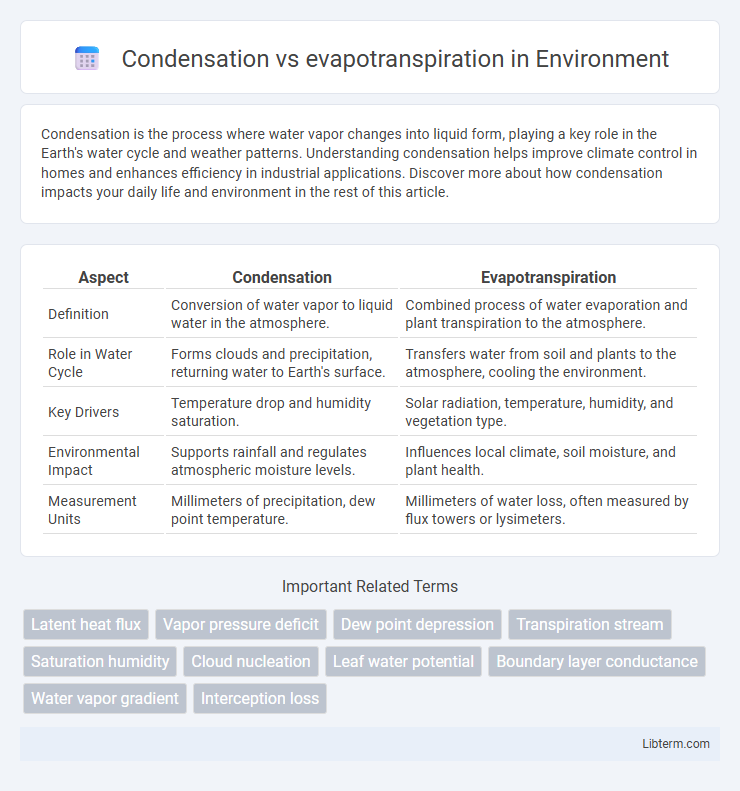Condensation is the process where water vapor changes into liquid form, playing a key role in the Earth's water cycle and weather patterns. Understanding condensation helps improve climate control in homes and enhances efficiency in industrial applications. Discover more about how condensation impacts your daily life and environment in the rest of this article.
Table of Comparison
| Aspect | Condensation | Evapotranspiration |
|---|---|---|
| Definition | Conversion of water vapor to liquid water in the atmosphere. | Combined process of water evaporation and plant transpiration to the atmosphere. |
| Role in Water Cycle | Forms clouds and precipitation, returning water to Earth's surface. | Transfers water from soil and plants to the atmosphere, cooling the environment. |
| Key Drivers | Temperature drop and humidity saturation. | Solar radiation, temperature, humidity, and vegetation type. |
| Environmental Impact | Supports rainfall and regulates atmospheric moisture levels. | Influences local climate, soil moisture, and plant health. |
| Measurement Units | Millimeters of precipitation, dew point temperature. | Millimeters of water loss, often measured by flux towers or lysimeters. |
Introduction to Condensation and Evapotranspiration
Condensation is the process where water vapor in the air cools and changes into liquid droplets, playing a crucial role in cloud formation and the water cycle. Evapotranspiration combines two processes: evaporation from soil and water surfaces, and transpiration from plants, both significantly influencing atmospheric moisture and climate regulation. Understanding these processes helps in managing water resources and modeling environmental systems.
Defining Condensation: Process and Importance
Condensation is the process by which water vapor in the air cools and changes into liquid water droplets, playing a crucial role in the water cycle by forming clouds and precipitation. This phase change helps regulate atmospheric moisture levels, influencing weather patterns and maintaining ecosystem balance. Condensation's significance extends to supporting life by replenishing freshwater sources and enabling plant growth through subsequent rainfall.
Understanding Evapotranspiration: Key Concepts
Evapotranspiration combines evaporation from soil and water surfaces with transpiration from plants, playing a critical role in the water cycle by regulating moisture transfer from land to atmosphere. Understanding evapotranspiration requires analyzing factors such as temperature, solar radiation, wind speed, and vegetation type, which influence water vapor flux. This process contrasts with condensation, where water vapor transitions back to liquid, highlighting the dynamic balance of water phases essential for climate and agricultural management.
The Water Cycle: Connecting Condensation and Evapotranspiration
Condensation plays a crucial role in the water cycle by transforming water vapor into liquid droplets, forming clouds that eventually release precipitation back to Earth. Evapotranspiration combines evaporation from soil and water surfaces with transpiration from plant leaves, driving the movement of water vapor into the atmosphere. This dynamic exchange links condensation and evapotranspiration, sustaining the continuous circulation of water that regulates climate and supports ecosystems.
Factors Affecting Condensation Rates
Condensation rates are primarily influenced by temperature, humidity, and surface properties, with cooler surfaces promoting higher condensation as air reaches its dew point. Air movement and atmospheric pressure also play critical roles; lower wind speeds and higher pressure tend to favor condensation by reducing the evaporation of moisture. Vegetation and soil moisture levels indirectly affect condensation by altering local humidity and temperature gradients.
Influences on Evapotranspiration Levels
Evapotranspiration levels are influenced by several key factors including temperature, solar radiation, humidity, wind speed, and vegetation type. Higher temperatures and increased solar radiation enhance evapotranspiration rates by providing the energy required for water to transition from liquid to vapor form. Vegetation characteristics such as leaf area index and root depth also play critical roles, as they determine the amount of water transpired, while wind speed accelerates the removal of water vapor from plant surfaces, further increasing evapotranspiration.
Environmental Impacts of Condensation
Condensation plays a critical role in the hydrological cycle by converting water vapor into liquid, influencing local microclimates and contributing to soil moisture replenishment. Excessive condensation can lead to increased surface moisture, promoting mold growth and accelerating material degradation, which impacts building structures and natural habitats. Unlike evapotranspiration, which removes water from ecosystems, condensation adds moisture, affecting atmospheric humidity levels and potentially altering weather patterns.
Ecological Significance of Evapotranspiration
Evapotranspiration plays a critical role in maintaining ecosystem water balance by returning moisture from soil and vegetation to the atmosphere, influencing local climate and hydrological cycles. It supports plant physiological processes and nutrient cycling while regulating soil moisture levels, which directly affects plant growth and ecosystem productivity. Compared to condensation, which primarily contributes to water input, evapotranspiration serves as a key mechanism driving the continuous movement of water through terrestrial ecosystems.
Differences Between Condensation and Evapotranspiration
Condensation is the process where water vapor in the air cools and changes into liquid droplets, typically forming clouds or dew, whereas evapotranspiration combines evaporation from soil and water surfaces with transpiration from plants, releasing water vapor into the atmosphere. Condensation results in the removal of moisture from the air, leading to precipitation or moisture buildup, while evapotranspiration increases atmospheric moisture through biological and physical processes. These contrasting roles highlight condensation as a moisture-gaining phase change and evapotranspiration as a moisture-losing process in the water cycle.
Practical Applications: Managing Water Resources
Condensation plays a critical role in water resource management by facilitating atmospheric moisture recovery, which is essential for rainwater harvesting and reducing evaporation losses in reservoirs. Evapotranspiration measurement informs irrigation scheduling and crop water requirements, optimizing agricultural water use and minimizing runoff. Integrating data on condensation and evapotranspiration enhances watershed management strategies, improving groundwater recharge and sustaining ecosystems.
Condensation Infographic

 libterm.com
libterm.com